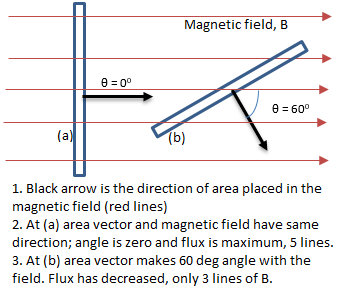Question 5: Define and explain magnetic flux.
ANSWER
Definition of Magnetic Flux
The total number of magnetic lines passing through a surface placed perpendicular to the magnetic field is called magnetic flux through that surface, denoted by Ф.
Explanation of Magnetic Flux
The flux of lines of induction is directly proportional to the cos of the angle between the area vector of the surface and the lines of induction; therefore, alternatively, flux is defined as the dot product of magnetic induction and the vector area. Hence,

Here θ is the angle between B and ∆A.

We know that area vector is normal to the plane of the area and if the area is not smooth then the angle between area vector and magnetic induction B is different at different points. In such a situation we divide the area into small segments, so that the area vector is constant over the whole segment. The total flux is then the sum of the fluxes of magnetic induction B through the individual area segments. Hence, total flux;


If B is uniform then,

Where  is the total area of the surface.
is the total area of the surface.
Special cases:
- If B and ΔA are parallel, then θ is zero and Φ= BA and the flux is maximum.
- If B and ΔA are perpendicular to one another, then, θ = 900 and cos θ = 0 and therefore, Φ= 0. The flux is minimum.
Unit of magnetic flux
In SI, unit of magnetic induction, B is tesla (T) and 1T= 1NA-1m-1. Similarly, unit of area is m2. Hence the unit of flux, Φ = BA = N A-1 m-1 m2 = N m A-1 1 N m A-1 is called 1 weber (Wb).
Flux density:
We know that Φ = BA cosθ
Now if B and A are parallel, = 0 and cos = 1. In such a case,
Φ = BA Or B = Φ/A
The above equation represents flux density. It is defined as, “flux per unit area is known as the flux density.”
This relation also shows the magnetic induction equals the magnetic flux per unit area when the area is at right angle to the magnetic field.
The unit of flux density is Wb m-2 = NA-1m-1.


Pingback:amperes-law-expression-for-a-solenoid – msa
Pingback:charge-to-mass-e-m-ratio – msa
Pingback:Electromagnetism, Physics 12 … msa – msa